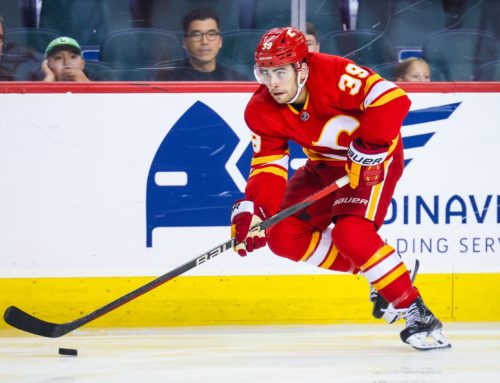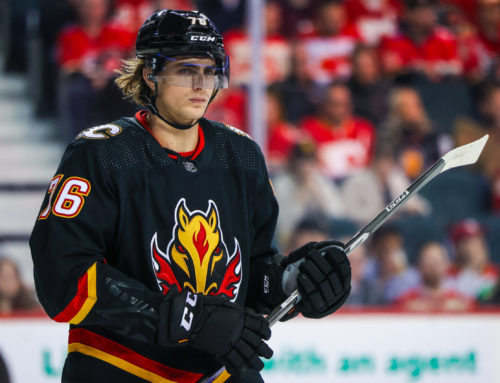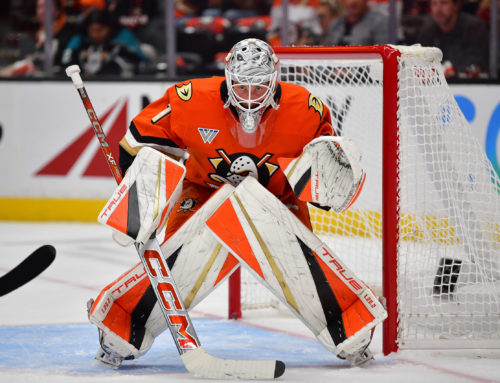
Earlier this week a general manager in one of my leagues posed a question around Vladimir Tarasenko and whether he should garner keeper consideration.
This is the same general manager that has kept Tarasenko for the past two seasons, all the while cursing him as he has failed to take the next step following a 75-point campaign three long seasons ago.
Of course, the answer to whether or not keeping Tank makes sense depends on your league parameters.
In this particular league, we only keep two players and it is mostly point based with a bonus for special teams points, game-winning goals, and hat tricks. It’s a weekly head-to-head format and Tarasenko finished 55th amongst forwards and defensemen this season:
|
Rank |
Player |
GP |
G |
A |
PPP |
SHP |
GWG |
HAT |
Fantasy Points |
|
54 |
82 |
9 |
53 |
39 |
0 |
2 |
0 |
165 |
|
|
55 |
76 |
33 |
35 |
22 |
0 |
5 |
1 |
164 |
|
|
56 |
81 |
27 |
43 |
18 |
2 |
3 |
1 |
164 |
With 16 teams in the league, ideally you want two of the top 32 projected players going into the following season.
There can be exceptions when picking someone outside of this previous season’s top 32 players due to injury or other circumstances (suspension, unsustainable shooting percentage for someone in the top 32, unsustainable bad luck, etc). See Auston Matthews who finished 45th in this setup but only played 68 games. He’s talented enough that you probably want to keep the young Leaf in almost any format.
Leagues like this are trickier when it comes to a player like Evgeni Malkin who finished 41st overall and only played 68 games. Malkin has consistently been out of the Penguins’ lineup when it matters most for fantasy owners and he isn’t getting any younger, but he still produces at an elite level when he’s healthy.
Does Malkin get even more rest (if that’s possible) next year down the stretch? Does he play more than 65 games regardless of the stretch run? Certainly a more difficult decision, and the answer probably depends mostly on who the other keeper choices are.
Malkin has been kept in this league every season and it was the right choice for the team that decided to keep him. On some of the top teams, Malkin wouldn’t quite make the cut based on similar output from the keepers but more consistency with games played.
The general manager in question has a lock keeper in Brad Marchand who finished fourth in this scoring format. His next best player is Alexander Ovechkin who finished 15th in scoring:
|
Rank |
Player |
GP |
G |
A |
PPP |
SHP |
GWG |
HAT |
Fantasy Points |
|
14 |
82 |
26 |
68 |
21 |
3 |
5 |
0 |
217 |
|
|
15 |
81 |
51 |
38 |
28 |
0 |
5 |
3 |
214 |
|
|
16 |
82
📢 advertisement:
|
27 |
55 |
36 |
0 |
10 |
1 |
211 |
To some the answer is quite quickly obvious. Marchand and Ovechkin are next year’s keepers, but this GM is like a lot of GM’s and is overly concerned about age.
For a lot of folks, it comes down to Tarasenko’s 27 years versus Ovechkin’s 33 years.
Going into next season it’s fairly safe to project Ovechkin’s floor at 70 points with a ceiling somewhere around 100 points, if everything were to go right for him. He likely ends up closer to the middle around 85 points with a heavy goal total. He’s still a beastly shooter, gets a ton of minutes, and has two top end centers to play with in Washington. The Great Eight isn’t going away next season.
Ovechkin has averaged 81 games played over the last five seasons as opposed to Malkin’s 68 games over the last five. In this head-to-head format health matters as the league locks weekly, so if someone gets injured after Monday you are hooped as he is stuck in your line up until the following Monday.
Oh, and let’s not forget Ovechkin is arguably the best goal scorer to every grace the NHL.
Now let’s dive into Tarasenko as the title of the article suggests we might. Let’s see if we think Tarasenko can take the next step as far as becoming a point-per-game player.
No doubt that there is some positive recency bias with Tarasenko as the Blues have been the best team in the NHL since January and are currently competing for the Stanley Cup.
Additionally, Tarasenko has been in the spotlight with very few NHL games currently being played. He’s hot right now and has produced an eight-game point streak with 10 points during that span (five goals and five assists).
However, prior to the recent point streak, people were talking about Tarasenko for all the wrong reasons during the Blues’ run this year as he struggled against Dallas in the second round and produced one goal in the previous six games with no assists. Like most goal scorers, he’s streaky.
For the totality of the playoffs, Tarasenko sits at 15 points (10 goals) in 21 games, which equates to 59 points over an 82-game span. Less than impressive for any fantasy owner expecting a PPG pace next year.
Outside of last seasons disappointing 66 points, Tarasenko has been remarkably consistent over the previous five years. He’s put up 73, 74, and 75-point seasons and he paced for 73 points this year (68 points in 76 games).
The disappointing 66-point season can easily be explained by the lowest shooting percentage (10.8%) since his rookie season. If we were to adjust his shooting percentage last year to his career average (12.1%), we get an additional four goals and he would have hit 70 points.
Let’s take a look at Tarasenko’s quarterly break down this season courtesy of Dobber’s Frozen Tools (https://frozenpool.dobbersports.com/players/vladimir-tarasenko):
|
2018-19 Quarter |
GP
|
G |
A |
PTS |
SOG |
PPP |
PPTOI |
TOI |
|
1 |
18 |
6 |
10 |
16 |
72 |
7 |
3:16 |
18:14 |
|
2 |
20 |
5 |
2 |
7 |
69 |
2 |
2:13 |
17:03 |
|
3 |
23 |
16 |
14 |
30 |
78 |
9 |
2:08 |
18:02 |
|
4 |
15 |
6 |
9 |
15 |
56 |
4 |
2:09 |
17:07 |
We can see a slower November/December and a hot January/February/March that mimicked the Blues down-up season. It looks pretty good as he finished the season at a 1.18 point-per-game pace over his last 38 games played.
Don’t let the small 38-game sample size fool you as Tarasenko has always been streaky and we’ve seen a slow down in the following 21 playoff games. Similar to Quarters 1 and 2, where he produced at a 0.61 point-per-game pace for 38 games. That’s a dismal 50-point pace over an 82 game season.
Another note from the chart is that Tarasenko’s ice time was down from last season’s career high of 19:03 minutes-per-game. His power play time was also down an average 29 seconds per game from last year.
He’s a good offensive player and a great goal scorer by today’s standards. The only mistake here is overvaluing him based on name value, especially in points only formats.
Multicategory formats will generally want Tarasenko on their team. Over the past two seasons he has averaged over hit per game, 291 shots, 0.49 blocks per game, and he’s been a plus player at +23. His cap hit is at 7.5 million until through the 2022-23 season.
In points-only leagues, draft or keep Tarasenko as a 70-point player and you will likely be very close with some upside. Expect him to take the next step and go 80-90 points and you will likely be disappointed.
All in all we have an extremely consistent 70-75 point player that has averaged 79 games per season over the last five years. Not too shabby, but not quite point per game.
When we label him consistent, it’s important to note that we are talking consistency over the course of an entire season. As demonstrated above, day-to-day or week-to-week Tarasenko can be extremely inconsistent. Day-to-day consistency matters a lot in some leagues and it doesn’t matter at all in others.
Could everything go right and we see Tank join the point-per-game club?
Sure, he could play 82 games, shoot a career high 16% (possible for a goal scorer of his caliber), and take 300 shots for only the second time in his career.
That would put him at 48 goals and his reasonably consistent 35 apples to just barely hit the mark. The much more likely scenario is another 70-75 points season. Just don’t expect it, and if it happens you’ll be pleasantly surprised.
In a limited keeper league like the one discussed, you ought to be thinking win every single year. If you can draft well and get a bit lucky with injuries you should always be in the mix in a format like this one. There is no rebuilding in a keep two, nor should there be keeping players for their future potential over established top-end players.
In order to regularly compete in these types of leagues you need to keep the two players that are most likely to score the most the following season and forget about almost anything beyond that, with very few exceptions to that rule.
With only 32 players kept there will always be a ton of borderline keepers available in the first round that are itching to take that next step. Some of them will and some of them won’t. Most years about half the GMs are able to improve their keepers at the draft in a format like this.
In this case Tarasenko should not garner keeper consideration, even if you still think he has point-per-game upside he should be redraftable in this setup. We are likely to see more of the same from him next season.





 FLA
FLA CHI
CHI NYR
NYR PIT
PIT L.A
L.A COL
COL CAR
CAR UTA
UTA SEA
SEA
 NYI
NYI TOR
TOR N.J
N.J
